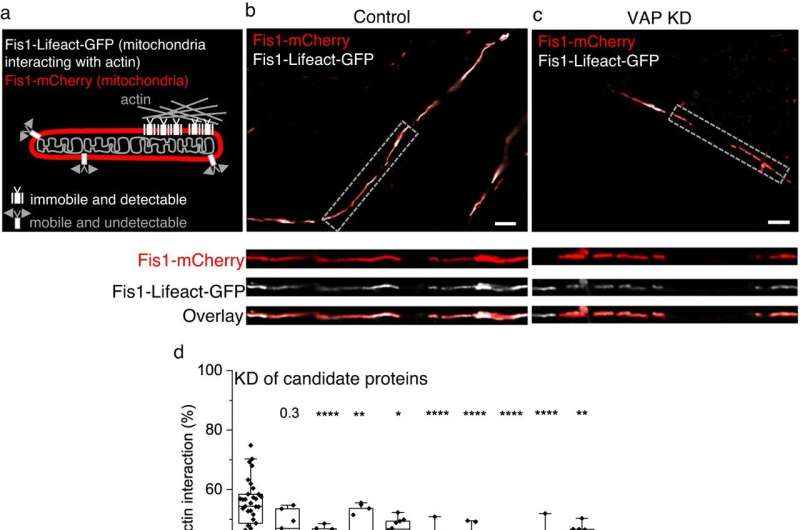This article has been reviewed according to Science X's editorial process and policies. Editors have highlighted the following attributes while ensuring the content's credibility:
fact-checked
peer-reviewed publication
trusted source
proofread
Scientists identify a molecular anchor that stabilizes mitochondria near synapses to support memory formation

When experiencing new things, the structure and function of our neurons and their connections are rapidly being remodeled. This process, known as synaptic plasticity, is critical for us to learn and adapt. However, these changes require a lot of energy.
Fortunately, our neurons are well-adapted to support these changes. Biological batteries known as mitochondria are strategically stabilized near sites of synaptic remodeling to ensure a local and efficient energy supply. However, how mitochondria are anchored near synapses is not known.
A team of scientists at Max Planck Florida Institute for Neuroscience has now identified a molecular anchor called VAP (vesicle-associated membrane protein-associated protein) that stabilizes mitochondria near synapses to support these remodeling projects.
The identification of VAP as a molecular anchor has particular significance because a mutation in VAP leads to ALS (amyotrophic lateral sclerosis), a progressive motor neuron degeneration disease. This discovery, published in Nature Communications, not only sheds light on how memories are powered but opens up new research directions into ALS pathology.
Lead scientist of the work and Max Planck Florida Institute Research Group Leader, Dr. Vidhya Rangaraju, describes the implications, "While we started this study to understand fundamental properties of how memories are powered, our findings open important new directions for our research. We will investigate the cellular mechanisms of the cognitive symptoms that often occur with motor symptoms in ALS but have been severely understudied. We believe the tools and approaches that we have established will begin to shine light into this area."
Stable mitochondria support the plasticity of synapses in dendrites
Neurons have an extensive, complex morphology and are constantly being remodeled. In order to energetically support these changes, mitochondria are anchored locally near synapses. This local stabilization allows the energy produced by the mitochondria to efficiently power local structural and functional changes in synapses during memory formation.
"This stability, however, is a unique feature of neuronal dendrites," explains Ojasee Bapat, the study's first author. "In neuronal axons, where mitochondria have been primarily studied, they are very mobile. We were interested in understanding how mitochondria are stabilized in dendrites and what this means for plasticity."
The search for a molecular anchor
To address this knowledge gap, the team took an unbiased approach to identify proteins that might serve as an anchor to stabilize dendritic mitochondria. The team used a chemogenetic tool that chemically marked all proteins present near the outer shell of the mitochondria. They then took advantage of advanced proteomics to determine the identity of the marked proteins. This screen identified over 100 proteins that might be responsible for anchoring the mitochondria.
To narrow their search, they selected proteins for their ability to interact with the actin cytoskeleton. The actin cytoskeleton is a network of protein filaments localized near synapses in dendrites that help to define and remodel synaptic structure. Previous work of Dr. Rangaraju and others has shown that mitochondrial stability in dendrites depends on actin. Only a handful of the initially identified candidate proteins could bind to actin.
To determine if these proteins were essential to mitochondrial stabilization, the authors genetically removed them one by one from neurons and looked at the stability of mitochondria in dendrites. What they found was striking.
ALS–linked protein VAP stabilizes mitochondria to support plasticity
The team discovered that when they removed one particular protein, named VAP, the interaction of mitochondria with actin was reduced. Additionally, dendritic mitochondria were shorter and destabilized. Without VAP to anchor the mitochondria by tethering it to the actin cytoskeleton, the mitochondria drifted away from synapses over time.
Finally, the researchers investigated if mitochondrial instability caused by removing VAP affected synaptic plasticity, the structural and functional remodeling of synapses during memory formation. To test this question, the team induced remodeling in a cluster of synapses and compared the structural changes to neurons that lacked VAP. In neurons in which VAP was removed, the remodeling was dramatically impaired. Induced changes in the structure of synapses could not be maintained in the absence of VAP.
A link to ALS leads to new research directions
The discovery that VAP serves as a mitochondrial anchor and supports memory formation holds particular significance. A single mutation in VAP causes a familial form of ALS, a fatal progressive motor neuron degeneration disease. Although VAP is associated with this specific and rare familial cause of the disease, the discovery suggests that mitochondrial stability and energetic support of plasticity are key cellular pathways that might contribute to disease pathology.
"The fact that our unbiased screen for mitochondrial tethering to the cytoskeleton identified a protein linked to neurodegenerative disease suggests that mitochondrial stabilization is a critical element in neuronal function and health," described Dr. Rangaraju.
"We are motivated to expand our research focus to understand what happens in the brain when mitochondrial energy availability is disrupted. We think this focus has the potential to find common mechanisms of neurodegeneration in ALS as well as other neurological disorders."
More information: Ojasee Bapat et al, VAP spatially stabilizes dendritic mitochondria to locally support synaptic plasticity, Nature Communications (2024). DOI: 10.1038/s41467-023-44233-8



















